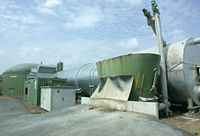
Photo from wikipedia
Biohydrogen (H2) is considered as a prospective energy source for altering of exhausting fossil fuel-based hydrogen in the coming years. Among biomaterials, lignocellulose is the most abundant renewable feedstock for… Click to show full abstract
Biohydrogen (H2) is considered as a prospective energy source for altering of exhausting fossil fuel-based hydrogen in the coming years. Among biomaterials, lignocellulose is the most abundant renewable feedstock for the second generation biohydrogen production through many processes. The conventional microbial fermentation and the photocatalytic reforming have received considerable attention that could convert the monosugars (mainly glucose and xylose) of the lignocellulosic materials into biohydrogen. In general, to obtain these monosugars, the lignocellulosic materials must be pre-treated through various complicated processes. This review focuses on various integrated pre-treating lignocellulosic material techniques and their advantages and disadvantages, including pretreatment, hydrolysis, and detoxification methods to get monosugars. Additionally, the state-of-the-art accomplishments in the post-methods, including microbial fermentation (including photo-fermentation and dark fermentation), microbial electrolysis, and photocatalytic reforming, for further converting monosugars into sustainable biohydrogen, are favorably highlighted. Finally, the perspectives for material pre-treating techniques and future challenges for post-methods to enhance biohydrogen are also discussed and intensified.
Journal Title: Biomass Conversion and Biorefinery
Year Published: 2020
Link to full text (if available)
Share on Social Media: Sign Up to like & get
recommendations!